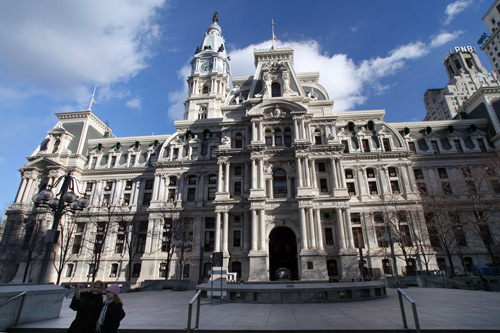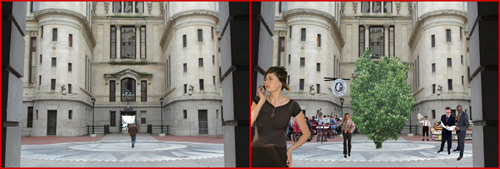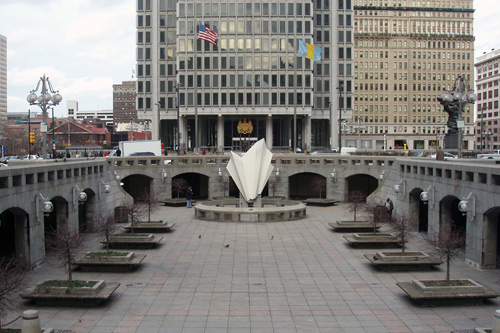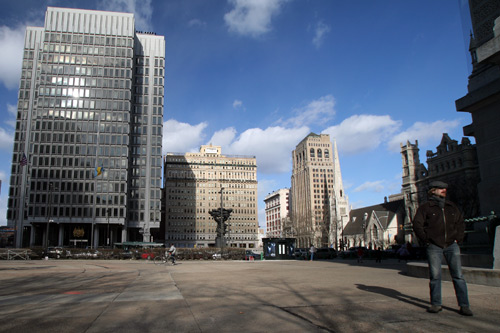|
|
|
25 January 07: Juggling and sipping . . . at City Hall?

How ambitious are we?
In 1871, we were feeling ambitious enough to design and build the largest municipal building in the world, a vision amplified by sculpture, carvings, symbolism, and the
world view that says we've taken into consideration the best that the world has to offer and now Philadelphia, it is yours. The world changed considerably by the time
the building was completed in 1901. Laden with corruption already, it appeared a relic of a pre-modern age, and ever since we've used it begrudgingly. That hardly
matters now. The fact is City Hall is the most brilliant thing we have. What we do with it today is a test of our ambition as a people.
My proposal covers only three areas: (1) stewardship, (2) the courtyard, (3) the "skirt," or exterior plazas. This is not a comprehensive plan for the building. Alas
the interior renovation, reorganization of the offices and court rooms, installation of HVAC, etc., etc., is for another time. The point here is get us started
possessing, enjoying, and thinking about this monument.
Stewardship: The Friends of City Hall
City Hall, unlike other city monuments like the Art Museum or Independence Hall, has no one outside of the Department of Public Property to manage its use, renovation,
art collection, historical interiors (one or the other of which is regularly damaged by fire or water), or to decide how to present its wonders to the public. The
wonderful folks in the Tour office have battled tooth and nail for recognition; finally their office is being renovated and will be a welcoming place for visitors who
wish to go to the tower or learn more, purchase souvenirs, and receive other information. New signage is also being installed.
Now let's form a non-profit organization, The Friends of City Hall, with a board independent of the mayor or council, with power to raise money, market, coordinate
renovations, curate the art collection, program all the public spaces, and manage the building as an historical site. Unlike city government, this organization will
have the power to draw funding from sources all over the world. Having it in place will make it easier for a mayor (or governor, ahem) to apply his own resources and
political capital to the effort. The money raised through sales of souvenirs, art replicas (there are more than 250 sculptures in the building, not to mention the big
one on top: totally untapped), tours, rent for courtyard spaces, etc., can be put toward a renovation and maintenance fund.
The Courtyard
Here, in the most important public gathering place in the city (the exact center of the original city and what is the fifth of Penn's five original squares —
still
considered Centre — or Penn Square), you've nowhere to sit, think, or look around at the bit of French Second Empire before you. (Forget Las Vegas, with this,
our
version of the French royal palaces, the Tuilleries and the New Louvre, with our own Place de la Concorde — Logan Square — Philadelphia was plucking,
copying, fantasizing a la postmodernism before the great-grandparents of the builders of New York, New York or the Venetian were even born.)
This plaza is larger than it seems. Remove the ugly planting beds and there's enough room for several cafes and restaurants, benches, and the broad walkways we now
enjoy, all the while maintaining the sense of intimacy and anonymity and openness. The goal is not to turn this into a private party, but to invite you, me, everyone,
to dwell here, to enjoy it.
The surface under foot should be a combination brick, Belgian block, and crushed limestone. And already there are lovely new (turn-of-the-twentieth-century) light
fixtures that match the original lamps braced to the walls.
At the center of the courtyard, install a large circle of outfacing benches around a fully-grown Franklinia, the tree discovered by John Bartram and named for his
compatriot, Ben Franklin (Ben needs his place here, as everywhere else, if for no other reason, über-poetically, that his persistence at the French court produced
the money for our revolution, bankrupting them, and causing theirs, ultimately putting the Tuilleries and the New Louvre in the hands of the people).
Let's liven things up, starting in the southwest corner: ice cream. We could hand this over to Capogiro because their gelato is supreme, but we ought to be mindful of
price, as this installation isn't meant to exclude. No: ice cream, Philadelphia-style. Bassetts, then: in a real turn-of-the-century get-up and tables for enjoying
the
treat.
Moving east, to the pair of miniature towers that flank the South Portico: La Colombe deserves this spot for many reasons, not the least of which is that they're
responsible for making Philadelphia a respectable coffee-roasting town once again. Here's what we do: Put their coffeemakers and espresso machines inside the east
tower, which is where you'll go to order your cappuccino. They'll maintain 35 small tables beneath both towers. The west tower can be used as a newsstand, with
displays of papers and magazines on racks just outside that tower door.

Moving around to the east side, inside the west wall of the tour office, room 121, and utilizing, if necessary interior rooms 115-119, facing into the center of the
courtyard, a small bar with another 30-50 tables. I haven't a good choice for the operator here, but envision something like an outside taproom. This will raise all
kinds of issues, of course, and will be subject to an assault on many fronts. Drinking in City Hall! Cavorting. Laughing too. We're breaking ground here.

In the northwest corner, using rooms 177-183 perhaps, just around the corner, a Marathon Grill, home-grown favorite of the lunch crowd. These folks
know how to feed a lot of people at a time, a certain requirement with 50-100 tables between the City Hall Tower archways and the West Portico.

It would behoove us to think for a minute about one other facet of the courtyard: the subway entrances and the station below. Currently there are four, one in each
corner. Though I'm the first to say public transit needs to be easier to use and more accessible, I think this might be a bit of overkill. My observations indicate
that the one that is used is the northeast stair (removing the others will simplify the space). It is also the one closest to the center of the courtyard, which means
there is room here to call attention to it. I'd like to see an architectural contest to re-design that entrance, with my mind's eye on something strikingly
contemporary, fully contrasted to the architecture around it (not so large, perhaps, as a glass pyramid — that's so eighties — somehow communicative with
the
clothespin outside). This may be a small matter — the entrance to a subway stop — but embracing transit here, at the heart of the city, carries massive
symbolic weight. More importantly, this is the city's great hub: you can get there from here, truly anywhere. So the station below, with service to seven subway and
trolley lines, and concourse connections to the now-renovated Suburban Station and fifteen regional lines, awaits complementary treatment. I don't speak of the generic
platform overhaul; rather a strong reference to the monument above: including displays of art from City Hall, historical and architectural descriptions, a directory and
floor plans, etc.
The Skirt
From the Marathon Grill, we pass through the old prisoner's entrance, the West Portico, with its symbols of sympathy (how arcane in these days of "empathy deficit," as
Barbara Ehernreich describes our culture in this month's Harper's), and out into the expanse of the city. Now we need the place to deliver us, entertain, excite. Now,
to the north, we have a toilet. Here's an almost unbelievable amount of space, mostly empty, but so well-proportioned, waiting. How ambitious are we?
Below is Dilworth Plaza, clean now, symmetrical, thoroughly empty. Let's hand this space over to local artists: 20 stalls for painters, photographers, etc. to show and
sell their stuff, with the Friends of City Hall to regulate, ensuring high quality. This is an old idea, of course, but a powerful one because it draws directly on
local talent, who too-often seem to be hidden. This is a result of particular Philadelphia problems: the lack of confidence in our own and the abhorrence of
commerce.

To add depth to the endeavor, the space could be used also for periodic shows of art (as compared to stalls) from international artists, perhaps a revolving sculpture
exhibit (of new work or of sculpture that now sits hidden away in the city's storage warehouses). Regarding this idea, it's important to remember this is the base of
the Parkway, our expanding art-amalgam.
Above, between the West Portico and the Northwest entrance, extending around to the North (ceremonial) face to the sculpture of Baldwin, we ought to hand this space to
Stephen Starr (love or hate him), making this the first, in sequence, of the proposed Parkway cafes. Let's see what big ideas he can come up with and we'll worry later
about how to incorporate a restaurant kitchen and indoor seating, if necessary, into the fabric of the building.
Beyond the restaurant, extending northwest to the corner, The Friends of City Hall can hire performers, such as dancers, jugglers, circus acts, perhaps with certain
local folkloric or ethnic resonance, to take up residence to entertain. This can be formally-devised, with a daily, revolving schedule, or informal, with acts
gathering
on whim, or on nice days.
Finally, I add another aspect to the circus we're creating, this idea borrowed in part from Penn, which last year had a program allowing scholars to stand at an outside
lectern and deliver a lecture of 60 seconds or less to the gathered public. I recommend we do this in a city-wide context, open to anyone, not just chosen scholars,
but
with a formal system of review to guard against abuse. Each day, at lunch time, perhaps ten people will have the opportunity to stand at the mike and speak: we'll call
it Philly Speak Your Mind!
Are we getting there? Leaping from a nineteenth to twentieth to twenty-first century notion of a city? I think we might be. The truth is these are small ideas, but
in
the context of a city that fears and resists its own celebrity, critical first steps. Start with the heart and everything else will follow.
We need folks who think this is a good idea and who have additional — better — ideas to help. We'll need the Center City District to get excited, the
historic commission, elected officials, the folks in the Tour Information Center. We'll need movers and shakers to form The Friends of City Hall. We'll need the Pew
Charitable Trust and the William Penn Foundation and others to adopt the idea. Takers?

–Nathaniel Popkin
nathaniel.popkin@gmail.com
|
POPKIN ARCHIVES:
|
|